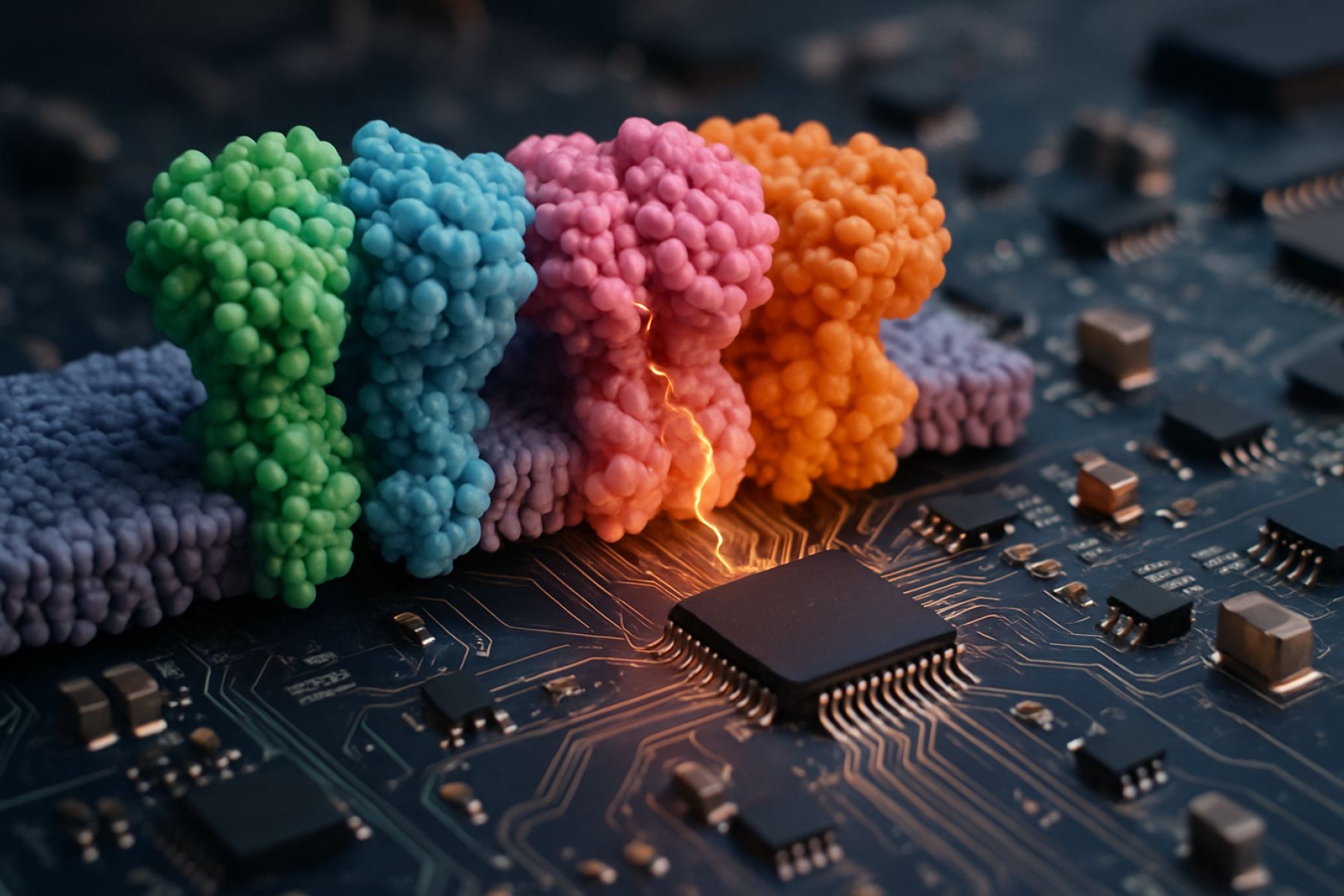How Voltage-Gated Ion Channels Are Revolutionizing Neuromorphic Computing: Unlocking Brain-Like Intelligence for Tomorrow’s Machines
- Introduction: Bridging Biology and Silicon
- What Are Voltage-Gated Ion Channels? A Primer
- Neuromorphic Computing: Mimicking the Brain’s Architecture
- The Role of Ion Channels in Biological Neural Processing
- Engineering Synthetic Ion Channels for Hardware Implementation
- Advantages Over Traditional Transistor-Based Systems
- Recent Breakthroughs and Experimental Prototypes
- Challenges in Integrating Ion Channels with Modern Electronics
- Potential Applications: From AI to Edge Devices
- Future Directions and Research Frontiers
- Conclusion: The Road Ahead for Neuromorphic Innovation
- Sources & References
Introduction: Bridging Biology and Silicon
Voltage-gated ion channels are fundamental to the electrical signaling in biological neurons, enabling rapid and selective ion flow in response to changes in membrane potential. These channels underpin the generation and propagation of action potentials, forming the basis for complex neural computation in the brain. Neuromorphic computing seeks to emulate such biological processes in silicon, aiming to achieve brain-like efficiency, adaptability, and parallelism in artificial systems. By bridging the gap between biology and technology, researchers are leveraging the principles of voltage-gated ion channels to design novel hardware architectures that move beyond traditional von Neumann computing paradigms.
The integration of voltage-gated ion channel dynamics into neuromorphic circuits allows for the replication of key neuronal behaviors, such as spiking, adaptation, and plasticity. This approach enables the development of devices that can process information in a distributed and event-driven manner, closely mirroring the operation of biological neural networks. Recent advances in materials science and nanoelectronics have facilitated the creation of artificial ion channels and memristive devices that mimic the conductance properties of their biological counterparts, paving the way for more energy-efficient and scalable neuromorphic systems Nature.
By drawing inspiration from the structure and function of voltage-gated ion channels, neuromorphic computing holds the promise of revolutionizing artificial intelligence, enabling machines to perform complex cognitive tasks with unprecedented speed and efficiency. This interdisciplinary endeavor not only deepens our understanding of neural computation but also drives innovation at the intersection of neuroscience, materials engineering, and computer science Frontiers in Neuroscience.
What Are Voltage-Gated Ion Channels? A Primer
Voltage-gated ion channels are specialized transmembrane proteins that regulate the flow of ions such as sodium (Na+), potassium (K+), calcium (Ca2+), and chloride (Cl–) across the cell membrane in response to changes in membrane potential. These channels are fundamental to the generation and propagation of electrical signals in neurons, enabling rapid and precise communication within the nervous system. The opening and closing of these channels are tightly controlled by voltage-sensing domains, which detect shifts in the electrical potential across the membrane and trigger conformational changes in the channel structure, allowing selective ion passage.
In the context of neuromorphic computing, voltage-gated ion channels serve as biological blueprints for designing artificial devices that emulate the dynamic and adaptive properties of neural circuits. By mimicking the gating mechanisms and ion selectivity of these channels, researchers aim to develop hardware capable of real-time signal processing, learning, and memory—key features of biological intelligence. The biophysical principles underlying voltage-gated ion channels, such as threshold activation, refractory periods, and frequency-dependent response, inspire the creation of novel electronic and memristive devices that can replicate the temporal and spatial dynamics of synaptic and neuronal activity Nature.
Understanding the structure-function relationship of voltage-gated ion channels is thus essential for advancing neuromorphic architectures. Insights from molecular neuroscience and electrophysiology inform the design of artificial synapses and neurons, bridging the gap between biological computation and next-generation information processing technologies Nature Materials.
Neuromorphic Computing: Mimicking the Brain’s Architecture
Neuromorphic computing seeks to emulate the structure and function of the human brain, aiming for energy-efficient, adaptive, and parallel information processing. Central to this approach is the replication of biological mechanisms such as voltage-gated ion channels, which are crucial for neuronal signaling. In the brain, these channels regulate the flow of ions across neuronal membranes, enabling the generation and propagation of action potentials that underlie complex cognitive functions. By mimicking these processes, neuromorphic systems aspire to achieve brain-like computational capabilities that surpass traditional von Neumann architectures in tasks such as pattern recognition, sensory processing, and learning.
Recent advances in materials science and device engineering have enabled the development of artificial devices that emulate the dynamic behavior of voltage-gated ion channels. For instance, memristive devices and phase-change materials can reproduce the nonlinear, time-dependent conductance changes observed in biological neurons, allowing for the implementation of spiking neural networks that closely resemble their biological counterparts. These innovations facilitate the creation of hardware that not only processes information in a distributed and parallel manner but also adapts and learns from experience, much like the human brain. The integration of such bio-inspired components into neuromorphic architectures holds promise for breakthroughs in low-power, real-time computing applications, including robotics, autonomous systems, and edge computing Nature, American Association for the Advancement of Science.
The Role of Ion Channels in Biological Neural Processing
Voltage-gated ion channels are fundamental to the electrical signaling mechanisms of biological neurons, enabling the rapid and selective flow of ions such as sodium, potassium, and calcium across cell membranes in response to changes in membrane potential. This dynamic regulation underpins the generation and propagation of action potentials, which are the primary means of information transmission in the nervous system. The precise timing and amplitude of these ionic currents allow for complex neural computations, including temporal coding, coincidence detection, and synaptic integration, all of which are essential for higher-order brain functions such as learning and memory Nature Reviews Neuroscience.
In biological systems, the diversity and distribution of voltage-gated ion channels contribute to the heterogeneity of neuronal responses, enabling a rich repertoire of signal processing capabilities. For example, the interplay between different types of potassium and sodium channels shapes the firing patterns of neurons, from regular spiking to bursting or fast adaptation. Moreover, the modulation of these channels by intracellular signaling pathways allows neurons to dynamically adjust their excitability in response to external stimuli or internal states Cell Press: Neuron.
Understanding the role of voltage-gated ion channels in biological neural processing provides critical insights for the design of neuromorphic computing systems. By emulating the biophysical properties and computational strategies of these channels, neuromorphic devices aim to replicate the efficiency, adaptability, and parallelism of the brain, paving the way for advanced artificial intelligence architectures that move beyond traditional digital paradigms Frontiers in Neuroscience.
Engineering Synthetic Ion Channels for Hardware Implementation
Engineering synthetic ion channels for hardware implementation represents a pivotal step in bridging the gap between biological neural systems and neuromorphic computing architectures. Unlike traditional silicon-based transistors, synthetic ion channels can emulate the dynamic, non-linear, and stochastic properties of biological voltage-gated ion channels, which are essential for complex information processing in the brain. Recent advances in materials science and nanotechnology have enabled the fabrication of artificial channels using organic polymers, solid-state nanopores, and hybrid bioelectronic interfaces that mimic the gating mechanisms and ion selectivity of their biological counterparts (Nature Nanotechnology).
A key engineering challenge lies in achieving precise control over the gating kinetics and conductance states of these synthetic channels. Researchers are leveraging molecular design and self-assembly techniques to tune the voltage sensitivity and response times, allowing for the creation of devices that can replicate the action potential firing and synaptic integration observed in neurons (Science). Furthermore, integrating these channels into scalable hardware platforms requires addressing issues of stability, reproducibility, and compatibility with existing microfabrication processes.
The successful implementation of synthetic ion channels in neuromorphic hardware could enable ultra-low-power, highly parallel information processing systems that surpass the efficiency of conventional electronics. Such systems hold promise for applications in adaptive learning, sensory processing, and autonomous robotics, where the unique properties of ion channel-based devices can be harnessed to achieve brain-like computational capabilities (Nature Electronics).
Advantages Over Traditional Transistor-Based Systems
Voltage-gated ion channels offer several compelling advantages over traditional transistor-based systems in the context of neuromorphic computing. Unlike conventional silicon transistors, which rely on binary switching and rigid circuit architectures, voltage-gated ion channels enable analog, event-driven processing that closely mimics the dynamic behavior of biological neurons. This results in significantly lower power consumption, as ion channels can remain in a low-energy state until activated by specific voltage thresholds, reducing the need for constant energy input and minimizing heat dissipation—a critical limitation in modern CMOS technology (Nature).
Furthermore, the inherent stochasticity and adaptability of ion channel dynamics facilitate robust information processing in noisy environments, a feature that is challenging to replicate with deterministic transistor circuits. This adaptability allows neuromorphic systems based on ion channels to exhibit learning and memory capabilities through mechanisms such as synaptic plasticity, which are essential for advanced cognitive functions (Science).
Another key advantage is scalability. Ion channel-based devices can be fabricated at the nanoscale, potentially surpassing the miniaturization limits of silicon transistors. Their biocompatibility also opens avenues for seamless integration with biological tissues, enabling hybrid bioelectronic systems for medical and brain-machine interface applications (Neuron). Collectively, these features position voltage-gated ion channels as a transformative technology for next-generation, energy-efficient, and adaptive neuromorphic computing platforms.
Recent Breakthroughs and Experimental Prototypes
Recent years have witnessed significant breakthroughs in the integration of voltage-gated ion channels into neuromorphic computing systems, aiming to emulate the complex dynamics of biological neurons with unprecedented fidelity. Researchers have successfully engineered artificial membranes and nanodevices that mimic the gating behavior of natural ion channels, enabling the development of hardware capable of real-time, energy-efficient signal processing. For instance, the use of solid-state nanopores and synthetic lipid bilayers has allowed for the recreation of action potential-like events, a critical step toward biologically realistic neural computation Nature Nanotechnology.
Experimental prototypes have demonstrated the feasibility of integrating these bioinspired components into neuromorphic circuits. Notably, hybrid systems combining organic electronics with ion channel-mimetic devices have shown promise in achieving synaptic plasticity and spike-timing-dependent learning, key features of brain-like computation Science. Additionally, advances in the fabrication of voltage-gated ion channel analogs using two-dimensional materials, such as graphene and transition metal dichalcogenides, have enabled the miniaturization and scalability of these systems for practical applications Nature Electronics.
These experimental achievements mark a pivotal step toward the realization of neuromorphic hardware that leverages the unique properties of voltage-gated ion channels, offering new avenues for low-power, adaptive, and highly parallel information processing architectures. Ongoing research continues to refine the stability, reproducibility, and integration of these prototypes, moving closer to their deployment in next-generation computing platforms.
Challenges in Integrating Ion Channels with Modern Electronics
Integrating voltage-gated ion channels with modern electronic platforms for neuromorphic computing presents a suite of formidable challenges. One primary obstacle is the fundamental mismatch between the operational environments of biological ion channels and conventional semiconductor devices. Ion channels function optimally in aqueous, physiological conditions, whereas silicon-based electronics require dry, controlled environments, making direct interfacing complex and often unreliable. This environmental incompatibility can lead to instability and degradation of biological components when exposed to standard electronic fabrication or operational processes (Nature Reviews Materials).
Another significant challenge lies in the scaling and reproducibility of hybrid devices. While individual ion channels can be reconstituted in artificial membranes, achieving large-scale, uniform arrays suitable for practical neuromorphic circuits remains difficult. Variability in channel incorporation, orientation, and function can result in inconsistent device performance, undermining the reliability required for computational applications (Science).
Furthermore, the integration of ion channels with electronic readout systems necessitates highly sensitive, low-noise amplification to detect the minute ionic currents involved. This often requires specialized materials and architectures, such as solid-state nanopores or organic transistors, which are still under active development and not yet standardized for large-scale manufacturing (Nature Nanotechnology). Finally, long-term stability and biocompatibility of these hybrid systems remain unresolved, as biological components may degrade or denature over time, limiting device lifespan and reliability. Addressing these challenges is crucial for the practical realization of ion channel-based neuromorphic computing systems.
Potential Applications: From AI to Edge Devices
Voltage-gated ion channels, fundamental to biological neural signaling, are inspiring a new generation of neuromorphic computing devices that promise to revolutionize artificial intelligence (AI) and edge computing. By emulating the dynamic, non-linear conductance and temporal response of these channels, neuromorphic systems can achieve energy-efficient, event-driven processing, closely mirroring the brain’s computational strategies. This approach is particularly advantageous for AI applications requiring real-time learning, adaptability, and low power consumption, such as autonomous vehicles, robotics, and smart sensors deployed at the edge of networks.
In edge devices, where computational resources and energy budgets are limited, hardware implementations of voltage-gated ion channel models enable local data processing and decision-making without constant reliance on cloud infrastructure. This not only reduces latency but also enhances privacy and security by minimizing data transmission. For instance, neuromorphic chips inspired by ion channel dynamics can perform complex pattern recognition or sensory data analysis directly on wearable health monitors or IoT devices, enabling rapid responses to environmental changes or user needs Nature.
Moreover, the inherent stochasticity and plasticity of voltage-gated ion channels can be harnessed to implement probabilistic computing and on-chip learning, paving the way for more robust and adaptive AI systems. As research progresses, integrating these bio-inspired mechanisms into scalable hardware platforms could bridge the gap between biological intelligence and artificial computation, unlocking new possibilities for distributed, intelligent edge technologies Science.
Future Directions and Research Frontiers
The integration of voltage-gated ion channels into neuromorphic computing architectures is poised to revolutionize the field by enabling devices that more closely emulate the dynamic and adaptive properties of biological neural networks. Future research is expected to focus on the development of novel materials and device structures that can replicate the complex gating kinetics and ion selectivity of natural channels. For instance, advances in organic electronics and two-dimensional materials may allow for the fabrication of artificial ion channels with tunable conductance and voltage sensitivity, paving the way for highly energy-efficient and scalable neuromorphic systems Nature.
Another promising direction involves the hybridization of biological and synthetic components, such as integrating reconstituted protein channels into solid-state devices. This approach could bridge the gap between the high fidelity of biological computation and the robustness of silicon-based technologies Science. Additionally, research into the stochastic and nonlinear behaviors of voltage-gated ion channels may inspire new computational paradigms, such as probabilistic or reservoir computing, which leverage the inherent noise and adaptability of these systems Neuron.
Looking ahead, interdisciplinary collaboration will be crucial, combining expertise from neuroscience, materials science, and electrical engineering to overcome challenges related to device integration, scalability, and long-term stability. As these frontiers are explored, voltage-gated ion channel-based neuromorphic devices could unlock unprecedented capabilities in artificial intelligence, adaptive sensing, and brain-machine interfaces.
Conclusion: The Road Ahead for Neuromorphic Innovation
The integration of voltage-gated ion channel dynamics into neuromorphic computing architectures marks a pivotal step toward bridging the gap between biological and artificial intelligence. As research advances, the emulation of these channels—central to neuronal excitability and signal propagation—enables the development of hardware that more faithfully replicates the temporal and adaptive properties of the brain. This approach promises not only enhanced computational efficiency but also the potential for real-time learning and robust sensory processing, features that are challenging to achieve with conventional silicon-based systems.
Looking forward, several key challenges and opportunities define the road ahead. Material innovation remains crucial, as the search for scalable, energy-efficient devices that can mimic the complex gating behaviors of biological ion channels continues. Emerging technologies such as memristive devices and organic electronics are showing promise in this regard, offering tunable conductance and biocompatibility Nature. Furthermore, interdisciplinary collaboration between neuroscientists, materials scientists, and computer engineers will be essential to translate biological insights into practical neuromorphic hardware Nature Reviews Materials.
Ultimately, the successful integration of voltage-gated ion channel principles could unlock new paradigms in artificial intelligence, enabling machines to process information with the speed, adaptability, and energy efficiency of the human brain. As the field matures, continued investment in fundamental research and cross-disciplinary innovation will be vital to realize the full potential of neuromorphic computing inspired by the intricacies of biological ion channels.











